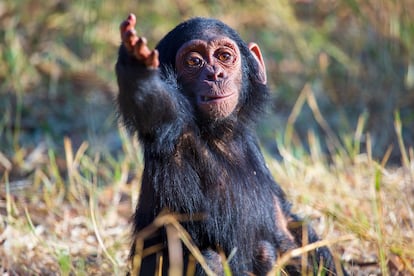Like human babies: Young chimpanzees also combine gestures and vocalizations to communicate
A recent study has shown that the development of communication in chimpanzees is similar to that of children

Northern Zambia is home to one of the world’s oldest and largest chimpanzee sanctuaries, the Chimfunshi Wildlife Orphanage Trust. Here, the animals live in four forest-filled enclosures measuring between 20 and 77 km². These large spaces offer chimpanzees the opportunity to perform many of their natural behaviors, such as foraging, climbing, building their nests in the treetops and socializing. For that reason, quite a few scientists have chosen this place to study chimpanzee behavior.
One of those researchers is Emma Doherty, a graduate student in the Department of Psychology at Durham University. For nine months between 2017 and 2021, she followed the youngest ones at the sanctuary to better understand how chimpanzees develop communication in the first years of their lives. She recently published her results in the journal Animal Behaviour, finding that young chimpanzees combine different gestures, vocalizations and facial expressions in a way that is reminiscent of the development of communication in human infants.
Gestures and speech are intimately linked
Human communication is not complete with speech alone. We need to add information with our gaze, facial expressions, gestures and body postures to make our messages less ambiguous. That’s why stickers and emojis are so popular in applications such as WhatsApp. Understanding the origins of this complex communication system has long intrigued scientists.
The close link between vocalizations and gestures occurs before we even learn to say words. By the end of the first year, children already begin to accompany babbling with gestures like pointing, reaching and showing. Not only do these two components overlap temporally, but they also have an interactive effect on language development.
There is considerable evidence that integrating gestures into communication facilitates the process of learning words. For example, a study carried out by several institutions in Spain’s northeastern region of Catalonia showed that 12-month-old babies who used gestures correctly when communicating acquired more vocabulary six months later.
But to understand the origin of human language, it is not enough to only investigate our babies. For years, science has also been examining chimpanzees’ vocalizations, gestures and facial expressions. We know that these primates’ vocalizations are quite rigid and instinctive; they’re similar to our laughing or crying. On the other hand, they use gestures rather flexibly, which more closely resembles our oral language.
Until now, each of these modalities has been studied in isolation in apes. The research conducted at Chimfunshi was the first to perform a multimodal analysis of baby chimpanzees’ communication. It turns out that they also combine vocalizations, gestures and facial expressions to avoid misunderstandings. For example, the chimpanzees in the study grinned with their mouths open while laughing, touched another individual while whimpering, and bared their teeth while screaming.
Specifically, these combinations were done in playful and aggressive contexts; these are the circumstances in which it is most important to make intentions clear. As in human infants, the multimodal communication of baby chimpanzees became more complex throughout infancy and adolescence.
The gestural hypothesis of language’s origins
This type of study is important for understanding the origin of human language, because the most widely accepted current hypothesis suggests that language originated with gestures.
All human cultures have language. Although we are not born knowing how to speak, language is in our nature somehow. But this is not a unique ability that suddenly appeared in the evolution of our species. Many of the capabilities required for human language — memory, learning, categorization, and the ability to attribute meaning to random signals — already existed in the ancestors we share with chimpanzees.
However, there are certain capabilities that must have appeared recently in our evolution. Some of the most relevant ones are vocal learning and the use of complex syntax, in which there are hierarchies and recursion. In the last hundred years, there have been many attempts to try to teach our language to apes. In some cases, we have succeeded in getting them to learn a large vocabulary through gestures or by pointing to symbols, but no ape has learned to use advanced grammar or say words.
Therefore, we know the ingredients that are necessary for language to emerge, but we lack the recipe, the theory that explains the order in which these capacities appeared and to what end. At this point, everything gets complicated because language does not stay the same, so any idea that is proposed usually lacks the necessary evidence to gain wide acceptance. However, one proposal predominates over the rest: the gestural hypothesis.
The idea that human language may have emerged from gestures is quite old. Merchants traveling to foreign lands in the 17th century realized that they could communicate using only bodily gestures. These observations led several intellectuals to propose that the language of gestures was the first of all languages.
Modern science took up this idea in the 1990s, with studies showing that deaf people’s sign language is as grammatically and semantically sophisticated as spoken languages. Children exposed to sign language from infancy learn it as easily and naturally as those exposed to speech; they even go through a stage of manual “babbling.”
In addition, neuroscience has shown that Broca’s area of the brain — which is involved in producing spoken language — is also activated when gestures are made. That reinforces the idea that there is a deep connection between processing gestures and speech. This evidence — along with studies of infants’ use of gestures and the famous cases of apes such as the gorilla Koko, who became quite proficient in sign language — have positioned the gestural language hypothesis as one of the most compelling ones.
If this hypothesis is correct, humans first developed a complex wordless proto-language that was based solely on gestures. It was only after we mastered that language that we moved the gestures from the hand to the mouth and larynx, articulating the sounds that would eventually become words.
Sign up for our weekly newsletter to get more English-language news coverage from EL PAÍS USA Edition
Tu suscripción se está usando en otro dispositivo
¿Quieres añadir otro usuario a tu suscripción?
Si continúas leyendo en este dispositivo, no se podrá leer en el otro.
FlechaTu suscripción se está usando en otro dispositivo y solo puedes acceder a EL PAÍS desde un dispositivo a la vez.
Si quieres compartir tu cuenta, cambia tu suscripción a la modalidad Premium, así podrás añadir otro usuario. Cada uno accederá con su propia cuenta de email, lo que os permitirá personalizar vuestra experiencia en EL PAÍS.
¿Tienes una suscripción de empresa? Accede aquí para contratar más cuentas.
En el caso de no saber quién está usando tu cuenta, te recomendamos cambiar tu contraseña aquí.
Si decides continuar compartiendo tu cuenta, este mensaje se mostrará en tu dispositivo y en el de la otra persona que está usando tu cuenta de forma indefinida, afectando a tu experiencia de lectura. Puedes consultar aquí los términos y condiciones de la suscripción digital.
More information
Archived In
Últimas noticias
The end of TPS threatens thousands of Haitians in Miami: ‘Returning is a death sentence’
Release of political prisoners in Venezuela: a gesture of openness under Trump’s shadow
Trump’s obsession with putting his name on everything is unprecedented in the United States
Trump announces US strikes against ISIS targets in Nigeria
Most viewed
- Charles Dubouloz, mountaineering star, retires at 36 with a farewell tour inspired by Walter Bonatti
- CBS in crisis after pulling a report on Trump’s deportations to El Salvador (which later leaked online)
- The Florida Keys tourist paradise is besieged by immigration agents: ‘We’ve never seen anything like this’
- December Social Security and SSI payments: Dates, double checks and the 2026 COLA increase
- Bukele clan fumes over investigation exposing their new wealth











































